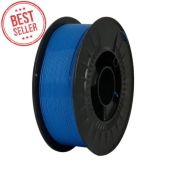We use cookies to make your experience better. Read more
12 August, 2024
What is PETG Filament - The Ideal Choice for Durable 3D Prints
What is PETG?
Polyethylene Terephthalate Glycol modified (PETG) is a synthetic thermoplastic polyester renowned for its exceptional chemical resistance, durability, and excellent formability. PETG is an incredibly versatile filament that balances mechanical properties with ease of printing, making it a popular choice for various applications in 3D printing. Its ability to offer good light diffusion and strong layer adhesion has led to its widespread use in manufacturing prototypes, functional parts, and even decorative items.
While PETG is a derivative of PET, it's important not to confuse it with other variations such as PETP (“pure PET”). PETG's glycol modified component provides distinct benefits, including enhanced clarity and ease of extrusion, which are critical for achieving high-quality prints.
PETG in 3D Printing: Applications and Benefits
Versatile Applications
PETG is widely used in vacuum and pressure forming applications due to its relatively low forming temperatures. It's also well-suited for routing, bending, and die-cutting processes, making it an ideal material for a variety of consumer and commercial uses. Some common applications include:
- Retail and medical packaging
- Advertising displays
- Electronic insulators
- Food containers and bottles
- Protective equipment and parts
In the world of 3D printing, PETG has almost the same ease of use as PLA, with the added benefits of better heat resistance and durability. These qualities make PETG a go-to material for product design teams focused on creating prototypes that must withstand stress and maintain structural integrity.
Key Performance Features
PETG is prized for several performance characteristics that set it apart from other 3D printing filaments:
- Ease of printing: Comparable to PLA, making it user-friendly for beginners and experts alike.
- Good layer adhesion: Ensures prints are strong and durable.
- Good light diffusion: Ideal for creating translucent or decorative items.
- Significant chemical resistance: Suitable for applications where the printed part may come into contact with various chemicals.
These features make PETG a reliable choice for prints that need to endure sustained or sudden stress, such as tools, 3D printer parts, and protective casings.
PETG Material Properties
Understanding the material properties of PETG is crucial for achieving the best printing results. Here are some typical properties for 3D printed PETG:
- Tensile Strength: 51 MPa
- Tensile Modulus (XY Direction): 2980 MPa
- Tensile Elongation at Break (XY Direction): 4%
- Glass Transition Temp: 80℃
- Density: 1.29 g/cm³ at 21°C
These properties highlight PETG's ability to produce strong, durable, and slightly flexible prints, making it an excellent choice for various practical applications.
Printer Requirements and Settings for PETG
While PETG is generally easy to print with, getting the best results requires understanding the specific settings and requirements for your 3D printer. Different brands and strands of PETG may require slightly different processing parameters. It's always a good idea to check the manufacturer's suggested settings for optimal printing results.
Recommended Printer Settings
For example, here are some general PETG recommendations for “bedslingers” (Creality, Anycubic, etc.):
- Print speed: 30-55 mm/s
- Extruder temperature: 230-240℃
- Bed temperature: 70-80℃
- Drying: 65℃ for 6 hours before printing
For faster printers like BambuLab, Creality K1, Ankermake, etc., we recommend slightly different settings:
- Print speed: 200 mm/s
- Extruder temperature: 245-255℃
- Bed temperature: 70-80℃
- Drying: 65℃ for 6 hours before printing
Drying brand new filament from the vacuum-sealed bag is not mandatory but is recommended for at least 2-3 hours.
These settings help ensure strong adhesion and reduce the chances of warping, leading to higher-quality prints.
Printing Temperature and Bed Temperature
The ideal print temperature for PETG typically falls between 220-255℃, depending on the filament brand. A heated bed, set between 50-80℃, is crucial for ensuring proper bed adhesion and minimizing warping. Some users also find that applying glue sticks or blue tape to the print bed can further improve adhesion.
Printing Speed and Retraction
Starting with a low print speed, around 30 mm/s, can help you fine-tune other settings like temperature. Once you’ve found the optimal settings, you can gradually increase the speed. PETG is prone to stringing, so adjusting the retraction settings is key to minimizing post-processing work.
Why Choose PETG for Your 3D Printing Needs?
PETG has become the second most popular 3D printing filament, overtaking ABS, and for good reason. It combines the strength of ABS with the flexibility and ease of printing akin to PLA, making it ideal for practical prints that require a bit more durability than PLA can offer.
Whether you're printing prototypes, functional parts, or even decorative items, PETG provides a balance of strength, flexibility, and heat resistance that makes it suitable for a wide range of applications.
PETG Filament at 3D Trček
At 3D Trček, we are proud to offer a premium selection of PETG filaments tailored to meet the diverse needs of our customers. Whether you're a hobbyist or a professional, our PETG filaments deliver the quality and consistency you need for your 3D printing projects.
Why Buy PETG from 3D Trček?
- High-Quality Filaments: We source our PETG filaments from reputable manufacturers to ensure consistent performance across all your prints.
- Wide Range of Colors: Our PETG filaments come in a variety of colors, allowing you to achieve the perfect aesthetic for your projects.
- Expert Support: Our team is always available to help you choose the right filament and offer advice on getting the best results from your 3D printer.
We understand that every project is unique, and our goal is to provide the materials and support you need to succeed. For more information about our PETG filaments, visit our PETG Filaments Page.
Get in Touch with Us
If you have any questions or need assistance, don’t hesitate to reach out. You can contact us through email at [email protected] or call us at +386 (0)1 242 83 60.
We look forward to helping you bring your 3D printing projects to life with the best PETG filaments on the market.
Comment(s)



Please complete your information below to login.
Sign In
Create New Account